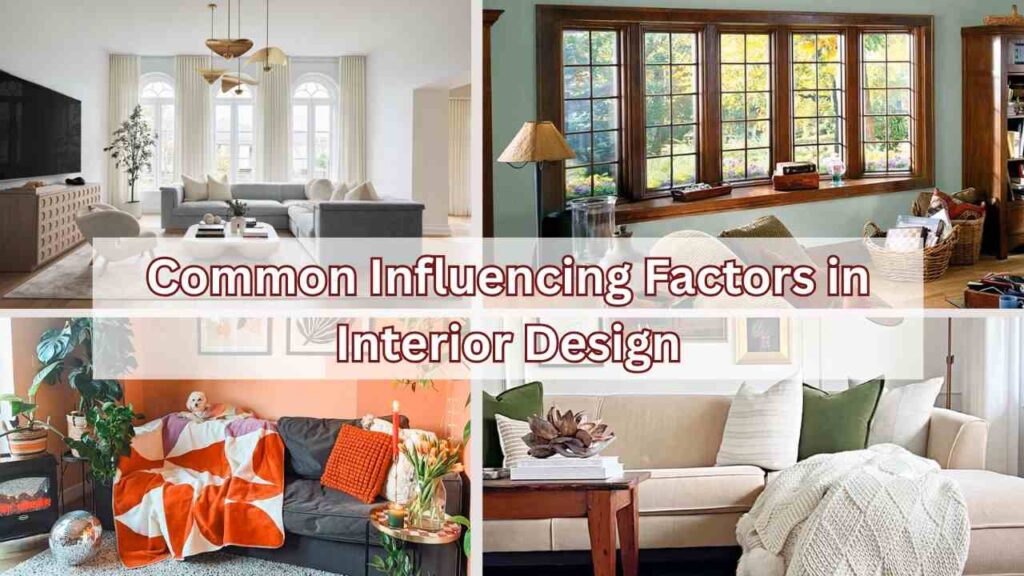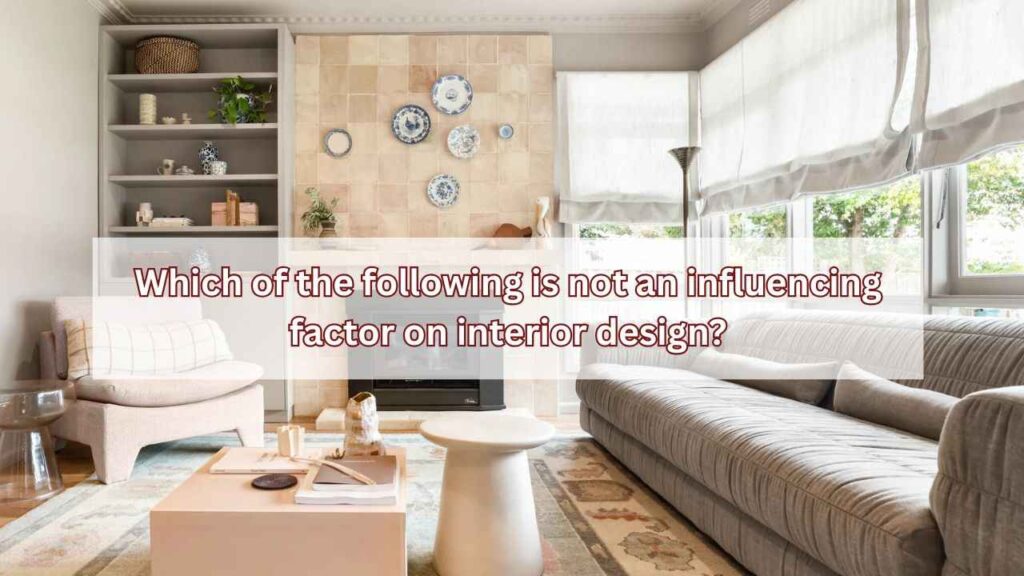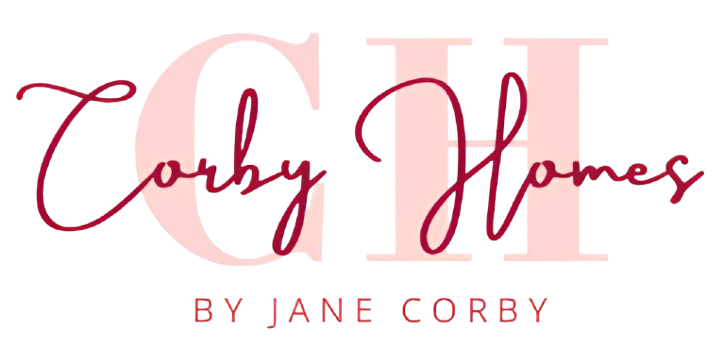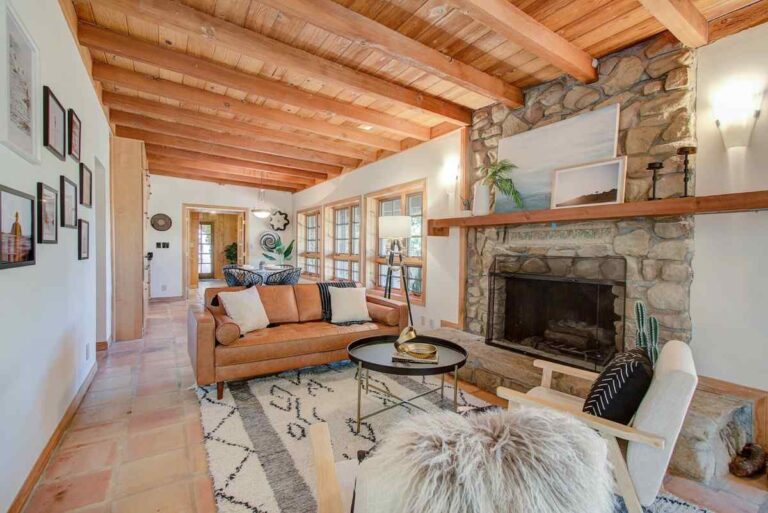Which of the following is not an influencing factor on interior design? If you’ve ever come across this question on an NCIDQ exam or in a home staging course, you might’ve scratched your head a bit.
The answer? Weather conditions. Yep, while a rainy day might affect your mood, it doesn’t actually influence how interior designers approach their work.
Unlike permanent elements like room dimensions or natural lighting, weather is temporary and external to the design process itself.
Interior design is influenced by so many factors that designers always consider.
Function, budget, client preferences, and spatial limitations top the list.
But then there are those things people think matter—like what their neighbour’s cousin thinks about orange accent walls or whatever trend blew up on social media last week.
These opinions and fleeting fads? Not actual design influencers.
In this post, I’m walking you through what really shapes interior design decisions versus what doesn’t.
Common Influencing Factors in Interior Design

Let’s talk about what actually matters in interior design. These are the non-negotiables that every designer worth their paint swatches considers before making a single decision.
I’ve seen so many beautiful spaces come together when these factors are properly addressed.
And I’ve seen just as many design disasters when they’re ignored.
From how a space functions to what your budget can handle, these influencing factors are like the recipe ingredients you can’t substitute.
Skip one, and your whole design falls flat.
Ready to learn what makes the list? Let’s dive in.
Function and usability
Function and usability are always at the top of any designer’s checklist. I mean, what’s the point of a gorgeous kitchen if you can’t actually cook in it?
This is about asking the real questions. How many people use this space? What activities happen here? Do you need storage, seating, or both?
A living room needs conversation areas. A home office needs proper lighting. A bedroom needs enough clearance to make the bed without gymnastics.
Function isn’t just practical—it’s personal. Your space has to work for your life, not some magazine spread.
Aesthetic Preferences
Aesthetic preferences are basically the personality of your space. This is where you get to say “This is SO me!”
I always tell clients that your home should make you happy when you walk through the door.
Do you love minimalist vibes or are you all about that cozy cottage feel? Are you drawn to bold colors or calming neutrals? Do you collect vintage finds or prefer sleek modern pieces?
There’s no right or wrong here—just what feels good to you.
The best designs reflect the people who live in them. Not what’s trending.
Budget
Let’s talk money. Budget isn’t just a limitation—it’s a guiding force in design decisions.
I’ve designed spaces with tiny budgets that look amazing and seen unlimited budgets produce spaces that feel totally soulless.
Your budget determines everything from materials to furniture to how much professional help you can bring in.
The good news? Great design is possible at any price point.
The trick is being honest about your numbers upfront and planning accordingly.
Remember, champagne taste on a beer budget just leads to frustration.
Style and aesthetics
Style and aesthetics are where the fun really happens.
This is about the overall vibe you’re going for.
I’ve found that most people don’t fit neatly into just one style box.
You might love boho patterns but also appreciate clean Scandinavian lines.
Your style isn’t just about following design rules—it’s about creating spaces that feel authentically you.
Look at what you’re naturally drawn to. Check your closet. Often your fashion choices hint at your design preferences.
Don’t worry about what’s “in” right now. Trends come and go, but your personal style is forever.
Regulations and building codes
Regulations and building codes aren’t exactly the sexy part of design, but ignore them and you’re asking for trouble.
These rules cover everything from electrical outlets to ceiling heights to how big your windows need to be for emergency exits.
They vary by location, too. What flies in Florida might not work in California.
If you’re moving walls, changing plumbing, or doing electrical work, PLEASE check local codes first.
Yes, permits are annoying. Yes, inspections can be stressful. But they exist to keep you safe, and that’s what really matters.
Space and Layout Considerations
Space and layout are basically the backbone of good design. You gotta work with what you’ve got.
I can’t tell you how many times I’ve seen furniture that’s totally wrong for a room’s size. Giant sectionals in tiny apartments? Not gonna work.
Your space dictates traffic flow, furniture placement, and even color choices. Small rooms might need lighter colors to feel bigger.
The best designers don’t fight against spatial limitations—they embrace them as creative challenges.
Measure everything before buying anything. Trust me, “eyeballing it” is how you end up with a couch stuck in your stairwell.
Historical and cultural context
Historical and cultural context can totally make or break a design. It’s about respecting where you are and what came before.
If you’re in a historic home, consider its architectural era.
Victorian? Craftsman? Mid-century? Each has its own design language.
Cultural influences matter too.
Maybe you’re incorporating elements from your heritage or honouring the local culture of your area.
This doesn’t mean you can’t be contemporary.
But acknowledging history gives your space depth and authenticity that brand-new cookie-cutter designs just don’t have.
Trends and Technology
Trends and technology definitely shape today’s interior design world, whether we like it or not!
I’m not saying you should jump on every trend bandwagon (please, not everything needs to be farmhouse), but being aware of what’s current keeps spaces feeling fresh.
Smart home tech is huge right now.
From lighting you control with your phone to fridges that order groceries, technology is changing how we interact with our spaces.
Sustainability trends are worth watching, too.
Energy-efficient appliances, eco-friendly materials,and indoor plants for air quality—all good stuff.
Non-Influencing Factors in Interior Design
Now let’s talk about what doesn’t matter in interior design, despite what some people might think.
These are the things that too many homeowners get hung up on, wasting precious time and energy that could be spent on what actually makes a difference.
I’ve seen so many design projects derailed because someone was focusing on the wrong things.
Understanding what doesn’t influence good design is just as important as knowing what does.
Ready to free yourself from these unnecessary design worries? Let’s break down the non-factors that you can officially stop stressing about.
Personal Opinions of Uninvolved Individuals
Personal opinions of uninvolved individuals are not design factors, no matter how loudly they’re shared.
Your neighbour thinks teal is “too bold” for a living room? Your cousin’s friend, who watched three episodes of a design show, hates your lighting fixture? Who cares.
I can’t tell you how many clients have second-guessed great design choices because of random comments from people who don’t even live there.
Here’s my rule: unless someone sleeps, eats, or pays bills in your space, their design opinions are just noise.
Your home should make you happy when you walk through the door, not your mother-in-law or that judgey friend from college.
Irrelevant elements
Irrelevant elements are those things that have absolutely nothing to do with creating a functional, beautiful space.
Or stressing about matching every single metal finish in a room. Mixed metals are actually more interesting.
I once had a client who wouldn’t buy the perfect sofa because it didn’t match the color of their neighbour’s living room. What?.
Another insisted their kitchen had to have an island because it was “in” – even though their space was way too small for one.
Focus on what affects your experience of the space, not arbitrary rules or silly comparisons.
Short-Term Trends
Short-term trends are like fashion fads – hot today, embarrassing tomorrow.
Remember when everyone was putting “Live Laugh Love” on their walls? Or when chevron print was everything? How about those Edison bulbs hanging from rope in every restaurant?
These super-specific trends don’t actually influence good design principles. They’re just momentary distractions.
I’m not saying trends are bad. Just be picky about which ones you invest in.
The fastest way to date your space is chasing every trend that pops up on social media.
Expensive Materials
Expensive materials do not automatically make for better design.
I’ve seen million-dollar homes with marble everything that feel cold and soulless.
And I’ve been in budget-friendly spaces that feel like a warm hug the minute you walk in.
Price tags aren’t design factors – they’re just numbers.
High-end materials can be gorgeous, sure.
But there are amazing look-alikes for almost everything now! Laminate that looks like real wood.
Porcelain tile that mimics marble.
Vinyl flooring that’s practically indestructible.
What matters is how materials work together to create the right feeling, not how much they cost.
Design is about creativity, not your credit limit.
Weather Conditions
Weather conditions have zero influence on good interior design.
Sure, you might feel inspired to redecorate when spring hits, but a rainy day shouldn’t dictate your color scheme.
I laugh when clients tell me they can’t use blue because they live somewhere cloudy, or that they need “warm colors” because it snows in winter.
Your heating system handles the actual temperature – your decor doesn’t need to compensate.
Climate might affect material choices for exteriors or sunrooms, but regular indoor spaces? Nope.
Think about it – the most beautiful homes in rainy Seattle don’t look fundamentally different from gorgeous interiors in sunny Miami.
Design for the long term, not for today’s forecast.
Short-Term or Over-Hyped Fads
Short-term or over-hyped fads are the design world’s equivalent of one-hit wonders.
Remember when people were turning pallets into everything? Or when everyone suddenly needed a barn door inside their very not-barn-like suburban home?
These flashy, of-the-moment crazes aren’t actual design influences – they’re just noise.
I had a client who insisted on filling her house with fiddle leaf fig trees because they were in every magazine.
Six months later? All dead, because she hated caring for plants.
Good design stands the test of time. Fads are forgotten faster than you can say “banana leaf wallpaper.”
Which of the following is not an influencing factor on interior design?

Let’s tackle that quiz question directly: “Which of the following is not an influencing factor on interior design?”
This is exactly the kind of thing that pops up on design certification exams and leaves students scratching their heads.
Let me create a sample quiz question for you:
Which of the following is NOT an influencing factor on interior design?
A) Client’s functional needs
B) Available budget
C) Current weather patterns
D) Building codes and regulations
The answer is C! Weather patterns don’t influence interior design decisions in any meaningful way.
Unlike the other options, which designers must consider for every project, whether it’s raining or sunny outside doesn’t affect how you arrange furniture or choose materials for indoor spaces.
Conclusion
Which of the following is not an influencing factor on interior design? Now you know the answer – others opinion.
While plenty of factors shape our design decisions, temporary external conditions like today’s forecast just don’t make the cut.
We’ve walked through what really matters in interior design: function, aesthetics, budget, style, regulations, space considerations, historical context, and long-term trends.
These are the non-negotiables that shape every successful design project.
We’ve also identified what to ignore: random opinions, irrelevant elements, short-lived trends, price tags alone, weather, and over-hyped fads.
Want to ace those interior design quizzes? Look around at real spaces that work well.
Visit model homes, browse design magazines, or even analyze restaurant interiors.
Ask yourself what factors influenced those designs and why certain choices were made.
FAQs
What are the factors of interior design?
The main factors include function, aesthetics, budget, style, regulations, space considerations, historical context, and technology.
These elements work together to create spaces that are both beautiful AND practical!
Which of the following is not a factor influencing the interior design industry?
Weather conditions! Unlike client needs or material availability, whether it’s sunny or rainy outside doesn’t impact how designers approach interior spaces.
What are the three F’s of interior design?
Form, function, and feeling! Good design looks right, works right, and feels right. Skip any of these and your space will never quite come together.
What are the 7 main elements of design in interior design?
Space, line, form, light, color, texture, and pattern. These building blocks combine in endless ways to create everything from cozy bedrooms to dramatic entryways.
What are the main factors that determine the design of a building?
Purpose, site conditions, budget, building codes, client needs, environmental factors, and cultural context. The exterior should reflect and support what happens inside!
What are the four basic factors common to all designs?
Function, aesthetics, durability, and cost. Whether designing a kitchen or a corporate office, these fundamentals always come into play!

